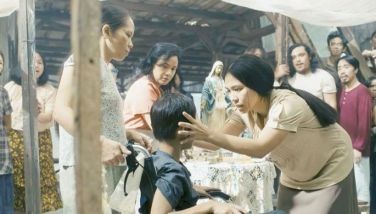Rediscovering true love in the shadow of death
MANILA, Philippines - The latest Marilou Diaz-Abaya film, Ikaw Ang Pag-ibig — which opens Sept. 14 in theaters nationwide — has deep resonances of love in varied levels.
It is the same kind of love put to test by fatal illness striking a member of the family. In this quiet but powerful film, everyone goes through an arduous trial of faith as impending death in the family looked inevitable. Concerned mother wails inside the church asking God why of all people, her priest son, is about to be taken away from her. Where did she go wrong? she asks.
Through it all, the estranged couple gets a second chance at reconciliation.
Ailing brother-priest gets through the untold secret of his sister through the confessional and rediscovers love for his sibling; mother and daughter struggle through family crisis brought about by rounds of hospital bills, and then rediscover love for each other. The unmarried mother and father rediscover that true and tested love — not social convention — is the true essence of love and marriage.
The filmmaker, of course, makes a strong pitch at the end of the film that true love springs from the divine and in the case of her latest film, from the intercession of the Virgin of Peñafrancia. Said she after the premiere night of Ikaw Ang Pag-ibig: “It is prayerfully hoped that my film would inspire viewers to love more, to love selflessly, to love God who is love!”
Anyway you look at it, you can watch the Abaya film in various true-to-life love scenarios.
The film puts on trial the acts of love as they are about to be tested by impending death in the family.
But by intent or coincidence, the Abaya film mirrors true-to-life scenarios of families coping with fatal illness like cancer. The filmmaker herself has been through rounds of chemotherapy since her breast cancer was discovered four years ago. The producer of Ikaw Ang Pag-ibig — Most Rev. Leonardo Legaspi, O.P.D.D. Archbishop of Caceres — had bouts with cancer before the film was finished. Abaya’s family friend — Johnny Delgado, husband of actor-director Laurice Guillen‚ passed away from cancer the other year. The ailing priest in the Abaya film played by Marvin Agustin is named Fr. Johnny.
I have a confused view of death as it applies to people in the arts.
 Marilou with the other members of the film’s cast and production staff
Marilou with the other members of the film’s cast and production staff I felt totally devastated when I got wind of writer Kerima Polotan’s death last Aug. 19. She stopped writing many years back but the impact of her earlier writings still dominate my writing life. No one wrote the way she did whether it be fiction or journalism. She is one of the triumvirate of women writers I admire namely Carmen Guerrero-Nakpil and Gilda Cordero Fernando.
I was a Luciano Pavarotti fan but I did not expect to behave the way I did when I got wind of his funeral flashed on CNN channel 13 years after I personally saw him in Manila. The long and grand funeral was grand opera by itself and it reminded me of the solemn funeral for the great Filipino composer, Nicanor Abelardo, in the mid-’30s. I was close to tears when the tenor was being laid to rest in his native Modena.
I rued then that opera fanatics must have felt the same way when the great Maria Callas died 34 years ago.
Callas’ love life and subsequent death was the subject of my conversation with Cherie Gil as she prepared for the role of Callas in the play, Master Class. When Gil accepted the part, she was still coping with the true-to-life curtain call for love and real-life marriage to a violinist-conductor. As Gil recalled how she prepared for the part, I couldn’t help recalling that Callas’ own tragic love life started when she met Aristotle Onassis and her singing took the back seat.
An outpouring of love is what friends and environmentalists always feel for arts patron Odette Alcantara. As in the case of Ishmael Bernal, Rolando Tinio and Pavarotti, I couldn’t easily accept Odette’s death and refused to attend her wake and the countless tributes in her behalf. I tend to relive the countless laughters we shared, the nuggets of wisdom I got from her and her grand determination to get things done to save the earth and to make it habitable for future generation.
Odette passed away three years ago on the same month the great Spanish pianist Alicia de La Rocha made her last curtain call. When Cecile Licad heard of her death, she was instantly sad and dedicated an encore piece to her — at the height of Typhoon Ondoy in Manila — during her performance in the birthplace of Elvis Presley in Mississippi on the year Ondoy hit Metro Manila. Licad who played Schumann in the upright piano of Odette said the environmentalist was a great lady and a great cook. She was in tears as she read Babeth Lolarga’s account of the life and times of Odette in a national daily. I rued then how much Licad loved Alcantara as a person and not just the perfect host.
Knowing how classical artists live their famous but sometimes, tragic existence, you’d be surprised to know their love lives often imitate the libretto of the opera, ballet and symphonic suites they were interpreting.
One of the most poignant scenes I have ever witnessed was in the wake of an international Filipino conductor. His only daughter came for the burial minus his son who just sent a letter which landed on top of the casket near his picture. In the letter, the son wrote how much he loved his father and poor son was sorry he but could not make it to his father’s last day on earth. The letter said he would remember their happy times and never mind that his marriage to his dear Mom didn’t work.
Here you see an artist who did everything in the name of music and was suddenly alone when his time came. But his passion for music “produced” grateful “sons” one of whom was from Romania whose homecoming concerts always begin with a regular visit to the conductor’s grave. He visited before rehearsals and visited again after performance before leaving for another overseas concert. I told myself not even true-to-life children would do that to a father.
Some singers have paid a price for building a career that did not even sustain them in the end. Another tenor preoccupied with his singing ended up neglecting his wife while he pursued scholarships abroad. He did win an international voice competition but lost his wife, got himself another one — not another singer this time, but a flutist who aspired to be a mezzo. This is another variation of the Traviata libretto where Alfredo deserts his Violeta to marry a real-life Flora (the mezzo character in this opera).
As with other humans, opera singers do have senseless bouts with sickness and death even after a colorful and fulfilling career.
Gamy Viray was still teaching even as the signs of a bad complications of diabetes began to set in.
Pavarotti was planning one concert after another even as he was coping with early signs of cancer.
The career of world-acclaimed Filipina mezzo Conchita Gaston was cut short by breast cancer. She died the way Violeta did in Traviata — by the verandah of her Amsterdam home — brave and resigned to death to the very end. Ishmael said he was inspired by the same Traviata death scene that he mounted a variation of the same death scene in another film starring Vilma Santos in was it Walang Katapusang Magdamag?
The death of dramatic soprano Remedios Bosch Jimenez was also very operatic. The initial stroke caught her in a church. She recovered but had another stroke, this time fatal, which found her fainting in another house of prayer. This was a scene straight from Tosca where the aria Vissi d’arte, visit d’amore (I have lived for art and love) clearly reflected her ideals as an artist. (This signature aria is probably lived to the hilt by her equally celebrated daughter, Rosemarie “Baby” Arenas.)
Until now I cannot get over the senseless death of tenor Don David who was murdered along with his wife in an isolated house by a hill in Binangonan, Rizal. This is a mindless Carmen in reverse, with the Don Jose being murdered in the presence of his loved one.
Speaking of celebrated illness among opera singers, it was Jose Carreras’ bout with leukemia that wags say propelled him to operatic (media) fame even before his celebrated concert tie-up with Placido Domingo and Pavarotti in Rome and Los Angeles.
Carreras, who sang in Manila in 1994, fought his illness like Calaf surviving the fatal riddle in Turandot whose signature aria, Nessum Dorma, is all about surviving life’s toughest challenges as reflected in that last phrase Vincero (I shall conquer). Carreras survived his fatal illness; La Gaston and La Jimenez including Pavarotti didn’t.
In this part of the Cultural Center of the Philippines (CCP) building where I used to work, there is a backdoor passage leading to an elevator where another secret door, when opened, gives you a complete view of the backstage area of the main theater.
During office hours, I would often become restless when I heard music emanating from that door. Out of curiosity, I would open it and, lo and behold, I would see artists doing their backstage rituals without knowing there was a pair of eyes monitoring them from the third-floor level of the stage.
In that same secret hallway, I saw the late American premier danseur Patrick Bissell warm up before his first Don Quixote in Manila in the early ‘80s. Years later, the American newspapers reported he was found dead in his bathroom.
It was from this vantage point that I saw the late Conching Rosal rehearse one of her last Carmen in Pilipino. The last time I saw her, she was singing in the funeral of opera lover, lawyer Honorio Poblador Sr. When she passed away, it was the turn of Irma Potenciano to sing for La Rosal.
This offstage area of the theater on both sides is called the wing and it is where the artists pray, concentrate, tremble or worry, as the case may be, before a performance.
Those few seconds before they go onstage is the time artists reckon if they will have a good performance or a bad one, the time when they wonder if there is an audience and whether it will be kind, indifferent or loving. How they handle that nervous moment before a performance often determines how a particular engagement will turn out.
In the last 40 years, I’ve seen artists go through that backstage ritual. Some aspiring young ones have made it, but others have not. Major talents have usually made more headway than the minor ones.
In the future, any film that will be done about classical artists and their equally colorful private lives should begin with a lingering camera shot in that part of the theater called the wing, with the performing artists recalling past and future triumphs and perhaps dwelling, without regret, on the stiff price they had to pay for heeding the call of their art.
When they pass away, you recall their great moments on stage while gently blurring the images of love and marriages that didn’t work, friendship that didn’t last, the fortune they didn’t make and the family ties that disintegrated as they braced for opening nights.
Come to think of it, love and death probably come in pairs. The latest Diaz-Abaya film— Ikaw Ang Pag-ibig — illustrates that.
As they are, love and death are still the great leveler and the great source of understanding and forgiveness in real life — and even in the arts.
- Latest
- Trending





























